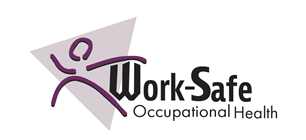
Work-Safe Occupation Health provides Worker’s Compensation Care, New Hire physicals, Fitness For Duty Exams, Return To Work Physicals, UDS & BAT Drug Testing, Respiratory Fit Exams, Ergonomic Job-Site Assessments, Rehabilitation, Work-Reconditioning, Audiology Base-Line Hearing Exams, and Asbestos Physicals among many other on-site programs. Lost work days and restricted work-days are reduced at the work-place. OSHA recordable injuries/illnesses are eliminated. The Health and Safety of the workforce is foremost. Job placement in transitional work until maximum medical improvement is achieved is our goal. Work-Safe coordinates all specialty referrals (e.g. surgeon for hernia repair, shoulder rotator cuff tear etc.).
Benefits :
- Immediate care with no waiting in Urgent Care for long periods of time.
- Access Equals Location there will be drive time savings, reduced medical visits, and reduced absenteeism from the job site.
- Days away restricted time (DART Score), lost work time, and restricted work time is improved by 20% and 25 % respectively.
- Lowering the opening -up of claims through on-site care
- Job Placement through Modified and Light duty transitional work is coordinated with the RN, worker, and supervisor to decrease lost work time, and for early return to work.
- Ergonomic assessment, frequency of incidents, mechanism of injury, and numbers of injury illness are analyzed by the on-site Work-Safe team to eliminate and prevent further injury/ illness, and / or claims.
- 20% reduction in reserves
- 15% reduction in cost per claim
- 20% improvement in lost work days
- 25% improvement in restricted work days
Preventive programs to reduce workplace injuries, to enable injured employees to continue to work, and to minimize lost work time of injured employees include
Prevention
• Work related injury/illness evaluation and treatment.
Disability Management for occupational & non-occupational injury/illness.
• Ergonomic On-Site Job Analysis.
• MSD evaluation including assessing posture and movements associated with conditions such as
• Cervical and lumbar back sprains and strains
• Lateral and medial epicondylitis
• De Quervain’s
• Carpal Tunnel Syndrome
• Others
Muscular Skeletal
Muscular Skeletal prevention programs include controlling and eliminating basic job risk factors of excessive force, repetition, and poor posture. Hand and back prevention classes include demonstration of back physiology, practice of lumbar stabilization postures, balance, stretching and strengthening exercises.
Additional Occupational Health Services
• Job coaching
• Workstation design and layout, physical demands of weight (e.g. never, rare, occasional, frequently, continuous), objects, height, postures/movements, maximum consecutive minutes/hours, total daily hours, and position change are assessed in relation to motion
• Industrial Rehabilitation
• Work Reconditioning
• Functional Capacity Evaluation
• Fitness for Duty
• Mobile Equipment Operators
• OSHA Hearing Conservation and Noise Exposure (e.g. noise monitoring, audiometric testing, hearing protection, retesting for suspect STS, record keeping and education)
• All drug and alcohol testing protocols (e.g. hair, pre-employment & post-accident)
• Biological effects (eye and skin) and hazard evaluation
• Organ systems (e.g. respiratory, dermatological) affected by toxic exposures
• litmus
• Otoscopic
• Strain, sprain, pain, headaches, burns , wound dressing, observed warning signs and symptoms of diabetes and/or hypertension
• And much more
